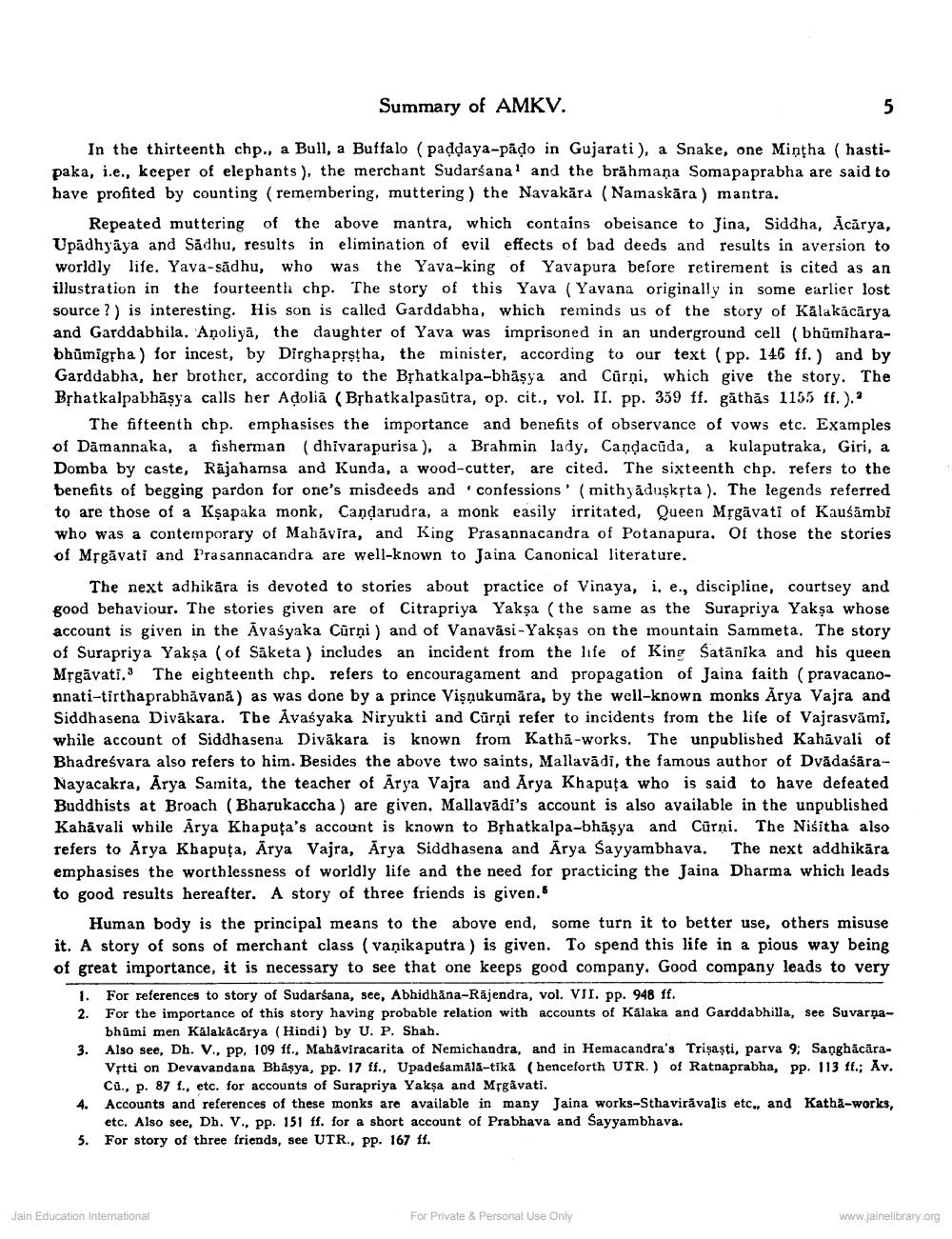________________
Summary of AMKV.
In the thirteenth chp., a Bull, a Buffalo (paddaya-pãdo in Gujarati), a Snake, one Mintha (hastipaka, i.e., keeper of elephants ), the merchant Sudarśanal and the brāhmaṇa Somapaprabha are said to have profited by counting (remembering, muttering) the Navakāra (Namaskāra ) mantra.
Repeated muttering of the above mantra, which contains obeisance to Jina, Siddha, Acārya, Upadhyāya and Sådhu, results in elimination of evil effects of bad deeds and results in aversion to worldly life. Yava-sadhu, who was the Yava-king of Yavapura before retirement is cited as an illustration in the fourteenth chp. The story of this Yava (Yavana originally in some earlier lost source?) is interesting. His son is called Garddabha, which reminds us of the story of Kālakácărya and Garddabhila. Anoliyā, the daughter of Yava was imprisoned in an underground cell (bhūmiharabhūmigrha ) for incest, by Dirghaprstha, the minister, according to our text (pp. 146 ff.) and by Garddabha, her brother, according to the Bșhatkalpa-bhāşya and Cūrņi, which give the story. The Bphatkalpabhāşya calls her Adolia (Bșhatkalpasūtra, op. cit., vol. II. pp. 359 ff. găthas 1155 ff.).'
The fifteenth chp. emphasises the importance and benefits of observance of vows etc. Examples of Dāmannaka, a fisherman (dhivarapurisa), a Brahmin lady, Candacūda, a kulaputraka, Giri, a Domba by caste, Rājahamsa and Kunda, a wood-cutter, are cited. The sixteenth chp. refers to the benefits of begging pardon for one's misdeeds and confessions (mithyāduşksta ). The legends referred to are those of a Kşapaka monk, Candarudra, a monk easily irritated, Queen Mrgāvati of Kausāmbi who was a contemporary of Mahavira, and King Prasannacandra of Potanapura. Of those the stories of Mrgāvati and Prasannacandra are well-known to Jaina Canonical literature.
The next adhikāra is devoted to stories about practice of Vinaya, i, e., discipline, courtsey and good behaviour. The stories given are of Citrapriya Yaksa (the same as the Surapriya Yakşa whose account is given in the Avaśyaka Curņi) and of Vanavāsi - Yakşas on the mountain Sammeta. The story of Surapriya Yaksa (of Saketa) includes an incident from the life of King Satānika and his queen Mrgāvati. The eighteenth chp. refers to encouragament and propagation of Jaina faith pravacanonnati-tirthaprabhāvanā) as was done by a prince Vişnukumāra, by the well-known monks Arya Vajra and Siddhasena Divakara. The Avaśyaka Niryukti and Cūrni refer to incidents from the life of Vajrasvāmi, while account of Siddhasena Divākara is known from Kathā-works. The unpublished Kahāvali of Bhadreśvara also refers to him. Besides the above two saints, Mallavādi, the famous author of DvādaśāraNayacakra, Arya Samita, the teacher of Arya Vajra and Arya Khapuța who is said to have defeated Buddhists at Broach (Bharukaccha) are given. Mallavādi's account is also available in the unpublished Kahāvali while Arya Khapuţa's account is known to Bșhatkalpa-bháşya and Cūrņi. The Niśitha also refers to Arya Khapuța, Arya Vajra, Arya Siddhasena and Arya Sayyambhaya. The next addhikāra emphasises the worthlessness of worldly life and the need for practicing the Jaina Dharma which leads to good results hereafter. A story of three friends is given.
Human body is the principal means to the above end, some turn it to better use, others misuse it. A story of sons of merchant class (vaņika putra ) is given. To spend this life in a pious way being of great importance, it is necessary to see that one keeps good company. Good company leads to very
1. For references to story of Sudarsana, see, Abhidhāna-Rajendra, vol. VII. pp. 948 ff. 2. For the importance of this story having probable relation with accounts of Kalaka and Garddabhilla, see Suvarna
bhūmi men Kalakācārya (Hindi) by U. P. Shah. 3. Also see, Dh. V., PP. 109 ff., Mahaviracarita of Nemichandra, and in Hemacandra's Trişaşti, parva 9; Sanghācāra
Vitti on Devavandana Bhäşya, pp. 17 ff., Upadeśamala-tikā (henceforth UTR) of Ratnaprabha, pp. 113 ff.; Av.
Ca., p. 87 f., etc. for accounts of Surapriya Yakşa and Mrgavati. 4. Accounts and references of these monks are available in many Jaina works-Sthaviravalis etc., and Katha-works,
etc. Also see, Dh. V., pp. 151 ff. for a short account of Prabhava and Sayyambhava. 5. For story of three friends, see UTR., PP. 167 ff.
Jain Education International
For Private & Personal Use Only
www.jainelibrary.org




